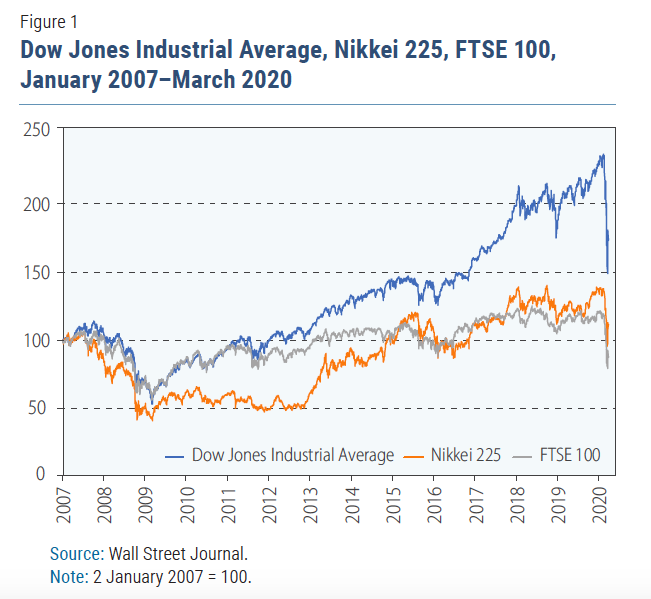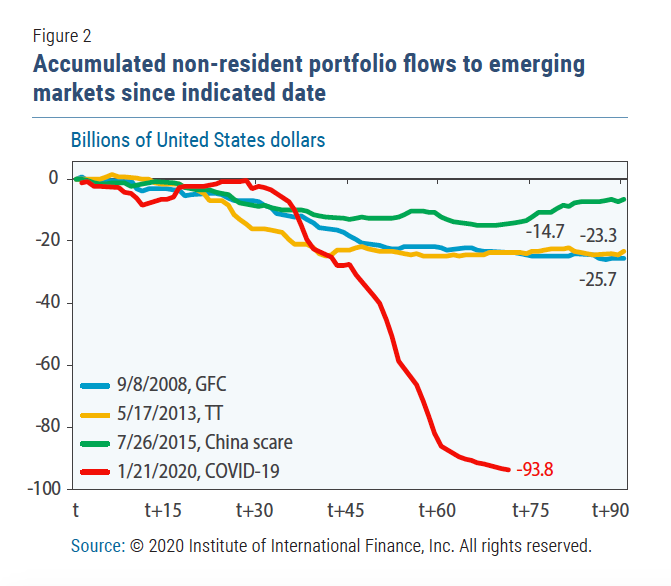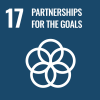
The COVID-19 pandemic is first and foremost a human crisis. Its most direct impact is on health and human well-being. The medical emergency and the public response to it — most importantly restrictions on movement — have also had a dramatic impact on economic activity, and led to significant job losses.
The global economy is now expected to enter into recession in 2020, following decade-low growth of 2.3 per cent in 2019. Although much of the focus to date has been on those countries that have been hit the hardest by the pandemic, the crisis has reverberated around the world, feeding through to financial markets.
Shocks to the real economy have led to three principal developments on global financial markets: (i) extreme global financial market volatility; (ii) large capital outflows and pressure on many developing countries’ foreign exchange rates and reserves; and (iii) a substantial increase in the risk of debt distress in public and private debt. These financial impacts are feeding back into the real economy, increasing the magnitude and duration of the recession.
This policy brief analyses the impact of COVID-19 on the financial sector and puts forward policy recommendations, focusing on how the international community can support countries most in need, in four areas: i) launching a large-scale, coordinated stimulus package that includes a significant increase in access to concessional financing; ii) strengthening the global financial safety net; iii) initiating a debt moratorium; and iv) in the medium-term, building a more sustainable future. These measures should complement other national and international actions to address the health, social and economic impact of the crisis.
Financial market turmoil
Since the scale of the COVID-19 shock became more broadly recognized in early March, global financial markets have witnessed heavy losses and intense volatility not seen since the onset of the 2008 world financial crisis. Financial markets in Asia, Europe and the Americas collapsed, with the Dow Jones registering its second-largest percentage drop in history on 16 March (Figure 1).
 Valuations have plunged across asset classes, as reflected in widening credit spreads (i.e. the interest cost borrowers pay above a benchmark, such as US Treasuries) on corporate and government bonds. For instance, according to some estimates, emerging market sovereign high yield spreads are currently pricing in an expected default rate of roughly 11 per cent (UBS Financial Services, 2020).
Valuations have plunged across asset classes, as reflected in widening credit spreads (i.e. the interest cost borrowers pay above a benchmark, such as US Treasuries) on corporate and government bonds. For instance, according to some estimates, emerging market sovereign high yield spreads are currently pricing in an expected default rate of roughly 11 per cent (UBS Financial Services, 2020).
Three related factors can help explain the volatility in asset prices: (i) the high risk of a global recession and its impact on corporate profitability; (ii) structural market issues, such as forced sales due to deleveraging; and (iii) fear and uncertainty, and panic selling. It is extremely difficult to discern how much of the selloff is due to each of these different factors. But the downturn is at least in part a response to the real economic impact of the pandemic, as reflected in sharp declines in the share prices of airlines, energy companies, financial institutions and manufacturing companies. There is an indication, however, that markets may have overshot, due to both fear and uncertainty and structural market issues. For example, current valuations of dividend futures imply that it would take over ten years for corporate earnings per share to reach the level of early 2020. This is an extremely long time compared to past economic and financial crises, after most of which earnings returned to previous levels within less than four years (Cembalest, 2020).
A high degree of leverage and vulnerabilities in the global economy prior to the crisis has contributed to the selloff (Chambers, 2020). As highlighted in the 2020 Financing for Sustainable Development Report (FSDR) (United Nations, 2020), while banking sectors in most countries have been strengthened since the 2008 crisis, risks have migrated to non-bank financial institutions (i.e., institutions that do not have a full banking license or are not supervised by a banking regulatory agency). The FSDR notes that the share of countries with vulnerabilities in non-bank financial institutions increased by almost 20 percentage points during the second half of 2019 alone, to reach levels similar to those before the 2008 crisis. In particular, “leveraged loans” (loans to higher risk corporate borrowers, most of which are then packaged into “collateralised loan obligations”) have doubled in volume since the 2008 crisis, to reach $1.2 trillion in 2019.
As a result of the high degree of leverage in the economy, widening credit spreads and falling asset prices associated with COVID-19 have triggered additional asset sales by fund managers to cover losses and repay debt, increasing pressure across markets. Downgrades by credit rating agencies may further worsen the spiral, as the mandates of many investors forbid them from holding bonds with sub-investment grade credit ratings. As this means higher funding costs for companies, it increases the likelihood of bankruptcies and layoffs, and can also reduce future investments, impacting future GDP growth. This is one reason why it is so important for central banks to continue to provide liquidity to markets.
Banks and other financial institutions will also likely see their earnings decline as a result of the pandemic, as the share of non-performing loans increases and interest rate margins fall as a result of reductions in policy rates. This is reflected in financial industry valuations, which fell roughly 39 per cent, significantly more than overall US markets. However, banks have more robust balance sheets than they did prior to the 2008 crisis, partly reflecting more stringent regulation — which should enable them to withstand some of the growth in non-performing loans. Indeed, banks can and already are playing an important role in mitigating the impact of COVID-19 on the real economy. They can roll over loans and provide loan forbearance where necessary, such as for SME loans and mortgage payments for individuals who have become liquidity-constrained.
Capital outflows from developing countries surge
The forced deleveraging across asset classes has also impacted many developing countries. Higher demand for dollar liquidity has led to unprecedented capital outflows from developing countries, particularly “emerging market” countries. Cumulative outflows since late January surpassed the levels documented at the peak of the 2008 Financial Crisis, representing the largest capital outflow ever recorded. As of March, investors had removed around $90bn from emerging markets since the start of the crisis (Figure 2).
 Similarly, credit spreads on emerging market sovereign bonds have widened to more than 600bps, more than doubling since the start of the year to reach a post-financial-crisis peak.
Similarly, credit spreads on emerging market sovereign bonds have widened to more than 600bps, more than doubling since the start of the year to reach a post-financial-crisis peak.
The capital outflow has led to a dramatic decline in emerging market currencies, with a number of currencies depreciating by more than 10 per cent. Given that a significant share of developing country public debt is in foreign currencies, mainly in US dollars, this will lead to a substantial increase in external debt servicing and refinancing costs for both corporations and governments. And for some developing countries the shortage in dollar liquidity and higher refinancing costs will undermine debt sustainability.
Debt distress on the horizon
Even before the COVID-19 pandemic, global debt had reached record highs, with 44 per cent of least developed countries (LDCs) and other low-income developing countries assessed at high risk of external debt distress or already in debt distress (defined by the IMF as experiencing difficulties in servicing existing debt levels). Both public and private debt are currently at record levels, with private debt in emerging markets having grown particularly fast following the 2008 crisis. In addition, the composition of sovereign debt changed in many developing countries. As the 2020 FSDR points out, the long period of unusually low international interest rates and unprecedented levels of global liquidity associated with quantitative easing provided developing countries, including least developed countries, increased access to commercial financing. While providing much needed resources in the short term, this has also resulted in higher debt servicing costs, and heightened interest rate, exchange rate and rollover risks.
With COVID-19 and related global economic and commodity price shocks, particularly the drop in oil prices (which was aggravated by political tensions), these risks are now materializing, putting significant pressure on debt sustainability in many countries. In Africa, six countries with high oil exports could experience significant shocks, while the fall in tourism will hurt many small island developing States and other tourism-dependent countries. In addition, highly leveraged corporations in developed and emerging economies are extremely vulnerable to shocks, which could amplify difficulties to service their debt.
In these extraordinary circumstances, resources to implement countercyclical measures and finance emergency health measures will be severely constrained in many countries. They will not be able to adequately respond to the health risks, let alone the economic and financial shocks associated with COVID-19. This calls for urgent action.
Policies to alleviate today’s turmoil and pave the way to a sustainable future
Governments must take immediate steps to address the human, economic and financial havoc being wrought by the COVID-19 pandemic and to prevent a potentially devastating debt crisis. Such policy responses need to be human-centred and gender-responsive. They should be designed to help those most in need, so that the burden of the crisis does not fall on those least able to bear it. And, as short-term policies today will affect future outcomes, even immediate crisis measures should be aligned with sustainable development.
At the national level, fiscal and monetary policies include: expanding public health spending, paid sick leave, wage subsidies and transfers, and granting loan forbearance and other assistance to struggling households and companies — along with injecting much needed liquidity to stabilize markets.
Developing countries that experience large, sudden capital outflows need to consider all options in the policy toolkit, including capital flow management policies. However, many countries, especially those with high debt burdens, will be constrained in the use of fiscal measures. The global community must support countries in need, both to ensure that no one is left behind and to effectively combat the pandemic.
At the international level, globally-coordinated rapid response measures would ensure maximum impact and signal global resolve to combat the pandemic and reignite inclusive growth. As many of the issues are global, multilateral cooperation will be necessary, including in health policies and international trade (e.g., eliminating barriers that affect global supply chains).
In addition, the international community must:
1. Support countries most in need
As called for by the UN Secretary-General, major economies should come together to launch a large-scale, coordinated stimulus package of at least 10 per cent of global GDP to help boost the world economy. This includes significantly increasing access to concessional financing for developing countries. As a first step, despite
enormous domestic pressures in the face of COVID-19, donors should immediately reverse the decline in official development assistance (ODA), particularly to LDCs, which may be hard hit by both social and economic impacts of COVID-19, and for whom ODA remains essential. In 2018, total ODA fell by 4.3 per cent and ODA to LDCs declined by 2.2 per cent in real terms.
2. Ensure adequate liquidity and resources
There are several immediate steps the international community can take to strengthen the global safety net.
Provide emergency funding: Support the IMF to increase its total lending resources to $2.5 trillion in order to respond to the increasing number of countries requesting emergency funds. As much of this increase as possible should come through quota-based resources. Donors should increase contributions to the IMF’s Poverty Reduction and Growth Trust (PRGT) and Catastrophe Containment and Relief Trust (CCRT) to finance concessional help during this crisis, to complement increases in ODA.
A sizable issuance of Special Drawing Rights (SDRs) by the IMF would provide international liquidity for all countries. Countries could enhance the liquidity impact of such an issuance by lending unused SDRs back to the IMF to increase its lending capacity.
An increase in central bank bilateral swap lines can help countries manage foreign exchange needs, particularly for US dollar liquidity. The US Federal Reserve has expanded the set of countries that are offered swap lines to 14 (mainly developed) countries. Central banks should consider extending such arrangements to additional countries in need.
3. Prevent a debt crisis
The international community should immediately suspend debt payments from least developed countries and other low-income countries that request forbearance. Official bilateral creditors must lead, and others should consider similar steps or equivalent ways to provide new finance. For example, the IMF has made enhancements to the CCRT to allow member low income countries debt service relief for up to two years.
An initial debt moratorium should also be a starting point for discussions of a more comprehensive assessment of debt sustainability and SDG achievement, with a view to consider longer-term measures of promoting debt sustainability and debt relief, where needed, while allowing for necessary public investments in the SDGs.
4. Build a more sustainable future through national and international actions
The current crisis provides a stark reminder of the importance of investment in public services and goods, including preparedness for economic and non-economic shocks. This includes: i) strengthening social protection; ii) accelerating long-term investment in resilient infrastructure for sustainable development, through public investment and incentives for the private sector; iii) increasing investment in risk management and preparedness; iv) enhancing regulatory frameworks, e.g., to discourage over-leverage when debt is not intended for productive investments (vs. increasing shareholder returns); and v) as noted above, strengthening the international financial safety net and the framework for debt sustainability. These and other policy responses should be sustained, sustainable and equitable, to avoid a rerun of the protracted and slow recovery from the 2008 crisis — and ensure implementation of the Addis Ababa Action Agenda and the Sustainable Development Goals.
 Welcome to the United Nations
Welcome to the United Nations
